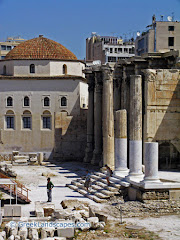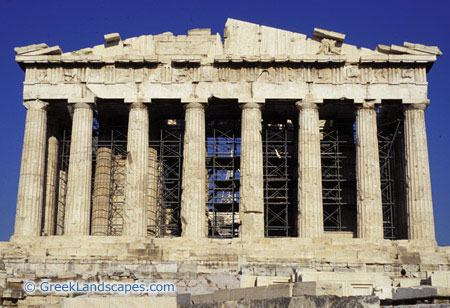 The Great Pyramid of Giza is the oldest and largest of the three pyramids in the Giza Necropolis bordering what is now Cairo, Egypt in Africa, and is the only remaining member of the Seven Wonders of the World. It is believed to have been built as a tomb for Fourth dynasty Egyptian pharaoh Khufu (hellenized as Χεωψ, Cheops) and constructed over a 20 year period concluding around 2560 BC. The tallest man-made structure in the world for over 3,800 years, it is sometimes called Khufu's Pyramid or the Pyramid of Khufu.
The Great Pyramid of Giza is the oldest and largest of the three pyramids in the Giza Necropolis bordering what is now Cairo, Egypt in Africa, and is the only remaining member of the Seven Wonders of the World. It is believed to have been built as a tomb for Fourth dynasty Egyptian pharaoh Khufu (hellenized as Χεωψ, Cheops) and constructed over a 20 year period concluding around 2560 BC. The tallest man-made structure in the world for over 3,800 years, it is sometimes called Khufu's Pyramid or the Pyramid of Khufu.

The lighthouse of Alexandria (or The Pharos of Alexandria, Greek: ὁ Φάρος τῆς Ἀλεξανδρείας) was a tower built in the 3rd century BC (between 285 and 247 BC) on the island of Pharos in Alexandria, Egypt to serve as that port's landmark, and later, its lighthouse.
With a height variously estimated at between 115 ~ 150 meters (377 ~ 492 ft) it was among the tallest man-made structures on Earth for many centuries, and was identified as one of the Seven Wonders of the World by Antipater of Sidon. It was the third tallest building after the two Great Pyramids (of Khufu and Khafra) for its entire life. Some scholars estimate a much taller height exceeding 180 meters that would make the tower the tallest building up to the 14th century.

Statue of Zeus at Olympia was one of the classical Seven Wonders of the Ancient World. It was made by the famed classical sculptor Phidias (5th century BC) circa 432 BC in Olympia, Greece. The seated statue, some 40 feet (12 meters) tall, occupied the whole width of the aisle of the temple built to house it. "It seems that if Zeus were to stand up," the geographer Strabo noted early in the 1st century BC, "he would unroof the temple." Zeus was a chryselephantine sculpture, made of ivory and accented with gold plating. In the sculpture, he was seated on a magnificent throne of cedarwood, inlaid with ivory, gold, ebony, and precious stones. In Zeus' right hand there was a small statue of Nike, the goddess of victory, and in his left hand, a shining sceptre on which an eagle perched. Plutarch, in his Life of the Roman general Aemilius Paulus, records that the victor over Macedon “was moved to his soul, as if he had beheld the god in person,” while the Greek orator Dio Chrysostom declared that a single glimpse of the statue would make a man forget his earthly troubles.
 Temple of Artemis (Greek: Ἀρτεμίσιον Artemision, Latin: Artemisium), also known less precisely as Temple of Diana, was a temple dedicated to Artemis completed in its most famous phase, around 550 BC at Ephesus (in present-day Turkey) under the Achaemenid dynasty of the Persian Empire. All but nothing remains of the temple, which was one of the Seven Wonders of the Ancient World. The Temple of Artemis was not the first on its site, where evidence of a sanctuary dates as early as the Bronze Age.
Temple of Artemis (Greek: Ἀρτεμίσιον Artemision, Latin: Artemisium), also known less precisely as Temple of Diana, was a temple dedicated to Artemis completed in its most famous phase, around 550 BC at Ephesus (in present-day Turkey) under the Achaemenid dynasty of the Persian Empire. All but nothing remains of the temple, which was one of the Seven Wonders of the Ancient World. The Temple of Artemis was not the first on its site, where evidence of a sanctuary dates as early as the Bronze Age. The temple was a 120-year project started by Croesus of Lydia. It was described by Antipater of Sidon, who compiled a list of the Seven Wonders:
I have set eyes on the wall of lofty Babylon on which is a road for chariots, and the statue of Zeus by the Alpheus, and the hanging gardens, and the colossus of the Sun, and the huge labour of the high pyramids, and the vast tomb of Mausolus; but when I saw the house of Artemis that mounted to the clouds, those other marvels lost their brilliancy, and I said, "Lo, apart from Olympus, the Sun never looked on aught (anything) so grand".

Tomb of Maussollos, Mausoleum of Maussollos or Mausoleum of Halicarnassus (in Greek, Μαυσωλεῖον Ἁλικαρνασσεύς, Μαυσωλεῖον τοῦ Ἁλικαρνασσοῦ (Ἀλικαρνασσοῦ)) was a tomb built between 353 and 350 BC at Halicarnassus (present Bodrum, Turkey) for Mausolus — a satrap in the Persian Empire — and Artemisia II of Caria, his wife and sister. The structure was designed by the Greek architects Satyrus and Pythius.It stood approximately 45 meters (135 feet) in height, and each of the four sides was adorned with sculptural reliefs created by each one of four Greek sculptors — Leochares, Bryaxis, Scopas of Paros and Timotheus.[3] The finished structure was considered to be such an aesthetic triumph that Antipater of Sidon identified it as one of his Seven Wonders of the Ancient World. The word mausoleum has since come to be used generically for any grand tomb, though "Mausol – eion" originally meant "[building] dedicated to Mausolus".
 The Hanging Gardens of Babylon
The Hanging Gardens of BabylonNear present day Al Hillah in Iraq
The Greek Historian Diodorus:
"The Garden was 100 feet long by 100 feet wide and built up in tiers so that it resembled a theater. Vaults had been constructed under the ascending terraces which carried the entire weight of the planted garden; the uppermost vault, which was seventy-five feet high, was the highest part of the garden, which, at this point, was on the same level as the city walls. The roofs of the vaults which supported the garden were constructed of stone beams some sixteen feet long, and over these were laid first a layer of reeds set in thick tar, then two courses of baked brick bonded by cement, and finally a covering of lead to prevent the moisture in the soil penetrating the roof. On top of this roof enough topsoil was heaped to allow the biggest trees to take root. The earth was leveled off and thickly planted with every kind of tree. And since the galleries projected one beyond the other, where they were sunlit, they contained conduits for the water which was raised by pumps in great abundance from the river, though no one outside could see it being done."
Source: Wikipedia, The Free Encyclopedia
























































No comments:
Post a Comment